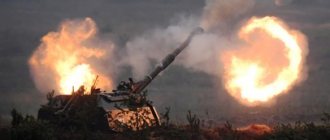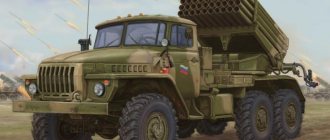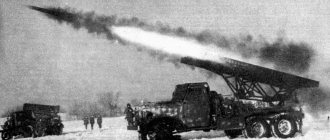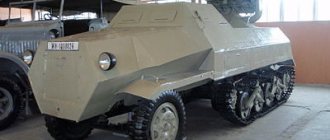History of creation
A few words should also be said about this.
The 240-mm Tulip mortar was supposed to replace the towed 240-mm M-240 mortar, released in 1950. The ballistic characteristics of these guns are approximately the same. However, the 2S4 is superior to the M-240 in terms of survivability in combat and firing efficiency due to improved maneuverability and maneuverability. In addition, it takes much less time than its predecessor to open fire and leave firing positions. A prototype of the new 240-mm mortar was developed at SKV in 1944-1945. The project was led by B.I. Shavyrin. Testing of the new gun began 2 years after the Victory and lasted until 1949. In 1950, the mortar was put into service with the army. In those days it was called the “240-mm M-240 mortar.” Its maximum target range was stated to be 8 thousand meters.
In 1953, a special charge was designed for the M-240 mortar, allowing it to increase the firing range to 9700 m. Serial production of the M-240 began in 1951 in the city of Yurga. A total of 329 installations of this brand were produced. The 240-mm M-240 mortar is a rigid system without recoil devices, loaded by a breech-loading method, has a wheeled carriage and fires finned mines.
Longest mine? Swept ammunition for 160 mm mortar
strangernn
The most unusual ammunition for a mortar was invented, it turns out... by the Finns.
160 Krh/58C in the late 50s
they were unable to adopt it under the terms of the agreements with the USSR, but so that a good thing would not go to waste, they offered it to the Israelis. They did not refuse, and soon the well-known Soltam M-66 was born.
But that’s not what we’re talking about, we’re talking about the Model 1/53 high explosive fin-stabilised discarding sabot
(HEFSDS). This is him in the photograph, in the hands of a Finnish mortarman.
The appearance of the projectile is due to the desire of the designers to increase the firing range of the mortar without increasing the pressure in the barrel and without increasing the hefty recoil. A light, long elongation sabot arrow seemed like a good solution to them, and they tried it.
They ended up with a rather complex ammunition, 1690 mm
, consisting of a long feathered arrow and a detachable….ahem.
pallet
_
Why am I having trouble with the name? Because this pan
was a rather clever coil-shaped aluminum structure. An arrow was inserted on one side of it, and on the other it ended in a perforated pipe with a mortar tail.
It flew away decently - if the mortar can shoot at 9.6 km with standard ammunition, then with the experimental arrow it was possible to shoot at all 16.
And everything would be fine, but there was one subtlety: the standard ammunition carried 5.4 kg of explosives, and only 1.542 kg was placed in an arrow with a caliber of only 80 mm (less than even in a 120 mm mine, it contains 2-2.5 kg).
And, not only that, the Finns were faced with the problem of proper detonation of a charge of such an extension: in order for everything to explode at once, they had to place three additional fuses along the length of the ammunition.
Therefore, after a series of experiments, the idea of shooting far with an arrow was abandoned. The game flew almost twice as far, yes, but it wasn’t worth the trouble.
This entry was originally posted at https://strangernn.dreamwidth.org/1626877.html. Please comment there using OpenID.
Howitzer M-30 model 1938 122-mm performance characteristics. Firing range. Dimensions. Weight
A battery of Soviet 122-mm M-30 howitzers, model 1938, fires at Berlin.
The 122mm M-30 howitzer, also known in the West as the M1938, is a stalwart veteran. It was developed back in 1938, and its industrial production began the following year. Produced in thousands and widely used in combat during the Great Patriotic War. The M-30, virtually unchanged, is still widely used in the CIS countries and many other countries, although at present in many armies it is used only for training purposes or transferred to reserve.
Routine work and first test
Yuri Tomashov headed the development. Even at the first stages of work, the team he led realized how many difficulties they would face. However, this did not frighten the team of military engineers, and the most eloquent evidence of this is the huge number of copyright patents received during development.
The professionalism of the employees and the full dedication of craftsmen at all levels allowed us to avoid many problems. However, considerable difficulties arose when working on the Tulip Mortar project. First of all, this affected the chassis. Initially, it was planned to equip the mortar with a tracked system, but its carrying capacity turned out to be too small. The weight that it had to carry reached 27 tons, and its capabilities were only enough for 21. Subsequently, together with specialists from the national cooperation of the defense complex, it was decided to equip the Tulip self-propelled mortar with a 520 hp engine. With. (instead of 400). The chassis was developed on the basis of the tractor of the RK Krug launcher. Y. Tomashov's team had to significantly refine and modernize the system, but overall the cooperation turned out to be fruitful.
Another difficulty arose during the first field tests. The system simply could not withstand its own impact. The blow was so strong that I had to abandon the idea that the impact would be absorbed by the frame. Only the earth could do this. Therefore, engineers had to urgently begin designing a special unit that would bring the barrel into a firing position.
After modernization, the Tulip mortar was tested a second time. It completely demolished a reinforced concrete pillbox, proving its effectiveness. In 1969, the Tulip self-propelled gun was put into production, and in 1971 it was officially put into service.
Combat use
The M-240 towed mortar received its baptism of fire in combat operations in Afghanistan this year. The D-30 howitzer battery of the 1074th artillery regiment of the 108th motorized rifle division was rearmed with 4 M-240 mortars in the second half of 1984. The mortars were towed by MT-LB tractors. The entire battery personnel were urgently sent for retraining to the territory of the USSR to a special center, where they were trained in the use of the 3F5 “Daredevil” mine. Upon returning to Afghanistan, the first successful test of the Daredevil mine in combat conditions was carried out in the Charikar Valley area. From that moment on, the M-240 battery actively participated in almost all army operations. In 1985, during the operation to destroy the Ahmad Shah Massoud group in the Panjshir gorge, the battery was tasked with destroying the Mujahideen fortifications that were impeding the advance of our units. Having turned around from the march and fired one sighting shot with a conventional high-explosive fragmentation mine, the battery then used the 3F5 “Daredevil” round. With an accurate hit, the target was completely destroyed. Due to the fact that the mortar has a slight rotation to the left and right, it was necessary to point all four guns in different directions. The target could appear from any direction, so the task was carried out by the weapon that was directed towards the target. With such firepower, one mortar was enough. Often, due to lack of time, preparation for firing was carried out according to topographic data, without taking into account weather conditions, nevertheless, targets were hit, as a rule, with one or two shots.
Mortar in the Technical Museum, Tolyatti
Subsequently, there were many other operations, and towed mortars everywhere proved themselves only from the best side. Later they were replaced by 2S4 Tulip self-propelled mortars.
M-240s were actively used against terrorists during Operation Damascus Steel in the spring of 2020 in the Damascus suburb of Eastern Ghouta by artillerymen of the strike unit of the Syrian armed Tiger Forces.
Notes
- [https://www.militaryparitet.com/nomen/russia/arty/mmet/data/ic_nomenrussiaartymmet/1/ 1. Battalion, regimental and divisional mortars] - Military parity
. - [https://www.gazeta.voenmeh.ru/n5-2004.htm KALACHNIKOV and modern artillery]. - “For engineering personnel.” Newspaper of BSTU "VOENMECH" named after. D. F. Ustinova, No. 5 (22503), April, 2004.
- Shcherbakov. About the combat use of M-240 mortars in Afghanistan. https://otvaga2004.ru/boyevoe-primenenie/boyevoye-primeneniye02/primenenie-minometov-m240/
- International Institute for Strategic Studies.
The Military Balance 2020 / James Hackett. - London: Taylor&Francis, 2020. - P. 332. - 504 p. — ISBN ISBN 9781857438352. - International Institute for Strategic Studies.
The Military Balance 2020 / James Hackett. - London: Taylor&Francis, 2020. - P. 354. - 504 p. — ISBN ISBN 9781857438352.
Tactical and technical characteristics of the M-240 mortar
- Adopted into service: 1950 - Designer: B. I. Shavyrin, SKB GA, Kolomna - Developed: 1944-1945 - Manufacturer: Plant No. 75, Yurga - Years of production: 1951-1958 - Total produced: 329 - Options: 2B8
Caliber: 240 mm
Crew (calculation): 11 (9) people
Weight of M-240 mortar
— Weight, kg: combat position: 3610, traveling: 4230
Overall dimensions of the M-240 mortar
- Length, mm: 6510 - Barrel length, mm: 5340 (20.8 klb) - Width, mm: 2430 - Height, mm: 2210
M-240 mortar shell
- high-explosive mines 53-F-864 and 53-F-865 (130.7 kg), - active-reactive 3F2 (228 kg), - guided 3F5 of the 1K113 “Daredevil” complex (134.2 kg), - nuclear mine 3BV4 (2 kt)
Rate of fire of the M-240 mortar
— 1 shots/min
Firing range of the M-240 mortar
— Maximum range, m: for F864: 800—9650, for 3F2: 19,690
- Initial projectile speed, m/s: 158—362 - Sight: panoramic MP-46 (MP-46M) - Shutter: piston, with a plastic shutter of the Banja system - Recoil device: without recoil devices (spring-type recoil absorber) - Carriage: two-wheel carriage
— Elevation angle: +45…+80° - Rotation angle: elevation 45°: 16°52″, elevation 80°: 78°
- Type of tractor: MT-LB, AT-T, AT-S, AT-L, Ural-375D - Transportation speed on the highway, km/h: 40
Links
Reserve Artillery of the Supreme High Command
| Mortars | 240 mm mortar mod. 1950 (M-240) 240-mm mortar 2S4 “Tulip” |
| Cannon | 180 mm S-23 cannon · 203 mm 2S7 "Pion" cannon |
| Howitzer | 203 mm howitzer B-4M |
| Reactive | 300 mm BM-30 “Smerch” |
Flak
| Large caliber | 152 mm KM-52 gun |
| Medium caliber | 85 mm KS-18 anti-aircraft gun · 100 mm KSM-65 anti-aircraft gun · 100 mm KS-19 anti-aircraft gun · 130 mm KS-30 anti-aircraft gun |
| Small caliber | 23 mm ZU-23 cannon · 23 mm ZSU-23-4 "Shilka" · 57 mm S-60 automatic cannon · 57 mm ZSU-57-2 · 30 mm 2S6 "Tunguska" · 30 mm 96K6 "Pantsir-S1" |
Naval artillery
Naval artillery
| MLRS | A-215 "Grad-M" · A-22 "Fire" · A-223 "Snow" |
| > 99mm | SM-2-1 AK-100 A-190 AK-130 A-192 |
| > 57mm | SM-24-ZIF · ZiF-31 · ZiF-75 · AK-725 · AK-726 · AK-176 · A-220 · A-220M |
| > 20mm | U-23 · 84-KM · 2M-3 · 2M-8 · 70-K · V-11 · SM-20-ZIF · AK-230 · AK-630 · 6K30GSh · AK-630M-2 |
Coastal artillery
| Stationary | MB-3-12 MB-2-180 MU-1 |
| Movable | KSM-65 SM-4-1 SM-9-1 BR-108 A-222 “Bereg” DP-62 “Damba” |
Performance characteristics of MT-12 Rapier
— Years of production: since 1970 — Crew, people: 6—7
Caliber MT-12 Rapier
— 100 mm
Overall dimensions of MT-12 Rapier
- Barrel length, bulb: 63 - Loading chamber length, mm: 915 - Gun width (by wheel caps), mm: 2320 - Stroke width, mm: 920 - Ground clearance, mm: 330 - Wheel diameter, mm: 1034 - Height line of fire, mm: 810- Height of the gun in firing position at the highest elevation angle, mm: 2600- Height of the gun along the upper cut of the shield, mm: 1600- Angle of horizontal fire, degrees: 53-54- Maximum angle of elevation, degrees: 20± 1- Maximum angle of descent, degrees: −6-7- Normal rollback length, mm: 680-770- Maximum rollback length, mm: 780
Weight of MT-12 Rapier
— Weight of the gun in combat and stowed positions, kg: 3100 — Weight of the barrel with bolt, kg: 1337 — Weight of the assembled wedge, kg: 55 — Weight of rolling parts, kg: 1420
Firing range of MT-12 Rapier
- High-explosive fragmentation projectile: 8200 m (mounted fire) - Armor-piercing sub-caliber projectile: 3000 m - Cumulative projectile: 5955 m
— Rate of fire, rds/min: 6—14- Initial projectile speed, m/s: 1575 (sub-caliber); 975 (cumulative) - Projectile mass, kg: 5.65 (sub-caliber); 4.69 kg (cumulative) - Sight: APN-6-40, OP4M-40U.
New Hope
The new leadership of the country, which replaced Khrushchev, fortunately, managed to assess the situation more adequately. The weapons that they did not have time to abandon and completely destroy were, to put it mildly, depressing. Samples of wartime equipment not only became physically unusable, but also became so morally obsolete that they could not stand any comparison with foreign-made analogues. And competitiveness in those days played a significant role. Fighting began in Vietnam, the Americans increased their power, investing huge amounts of money and effort into military developments. The Cold War was just around the corner...
All this led to a resolution of the Central Committee on the development and creation of completely new self-propelled artillery systems. The deadly “bouquet” was collected thanks to several military factories. The Kharkov tractor-tank plant launched production of the 2S2 “Gvozdika” (caliber 122 mm), the production of 122-mm “Violets” started in Volgograd, and the factories of the Urals immediately began producing two self-propelled guns - the 152-mm howitzer “Akatsiya” and the 240-mm mortar 2S4 “Tulip” "
Tactical and technical characteristics of the Sturmtiger
- Layout diagram: Engine compartment in the rear, transmission in the front, combat in the middle. - Developer: Alkett - Years of development: 1943-1944 - Years of production: 1944-1945 - Years of operation: 1944-1945 - Number of issued, pcs.: 18
Crew: 5 people
Weight Sturmtiger
— Combat weight, t: 66
Overall dimensions of the Sturmtiger
- Hull length, mm: 6280 - Length with gun forward, mm: 6280 - Width, mm: 3705 - Height, mm: 2850 - Ground clearance, mm: 485
Reservation Sturmtiger
— Armor type: Steel chromium-molybdenum rolled and cast surface-hardened - Hull forehead (top), mm/deg.: 70 / 80° - Hull forehead (middle), mm/deg.: 100 (+50) / 25° - Hull forehead (bottom), mm/deg.: 62 / 65° - Hull side (top), mm/deg.: 82 / 0° - Hull side (bottom), mm/deg.: 62 / 0° - Hull rear (top ), mm/deg.: 82 / 8°- Hull stern (bottom), mm/deg.: 62 / 48°- Hull roof, mm: 28- Cabin front, mm/deg.: 150 / 47°- Cabin side , mm/deg.: 82 / 20° - Cabin feed, mm/deg.: 82 / 10° - Cabin roof, mm/deg.: 40
Armament Sturmtiger
— Caliber and brand of gun: StuM RM 61 L/5.4 caliber 380 mm — Gun type: Rocket bomber — Barrel length, calibers: 5.4 calibers — Gun ammunition: 14 rockets — VN angles, degrees: 0…+ 85°- GN angles, degrees: ±10°- Sights: Pak ZF 3×8 optical sight
— Machine guns: 1 MG 34 machine gun, 7.92 mm caliber
Engine Sturmtiger
- Engine type: Maybach HL 210 P30, 12-cylinder, carburetor, V-shaped, liquid cooling, power 650 hp (478 kW) at 2600 rpm, displacement 23,095 cc - Engine power , l. pp.: 650
Speed Sturmtiger
— Highway speed, km/h: 38.2 - Cross-country speed, km/h: 38.2
- Cruising range on the highway, km: 100 - Cruising range over rough terrain, km: 100 - Specific power, l. s./t: 10.6 - Suspension type: Individual torsion bar - Specific ground pressure, kg/cm²: 1.18
— Overcome ascent, degree: 36° - Overcome wall, m: 0.79 - Overcome ditch, m: 2.3 - Overcome ford, m: 1.2
Characteristics
The 2S4 “Tulpan” self-propelled mortar is the most powerful mortar in the world. Its caliber is 240 millimeters.
The mortar has high maneuverability and the effectiveness of mines at the target, the ability to overcome contaminated areas of terrain, and high maneuverability.
To fire a mortar, no special preparation of the position before shooting is required. The loading angle of the 2B8 is about +63°. Mines are supplied to the rammer guides automatically from a mechanical ammunition rack located in the chassis body (two ammunition racks contain 40 high-explosive or 20 active-reactive mines). In addition, loading can be done from the ground using a crane. Horizontal guidance remained manual.
The V-59 diesel engine installed on the 2S4 allows you to reach speeds of up to 60 km/h on the highway, and up to 30 km/h on dirt roads.
The mortar fires a steel high-explosive mine F-864 weighing 130.7 kg with a bursting charge mass of 32 kg. The GVMZ-7 fuse has settings for instantaneous and delayed action. The F-864 mine with the VF-864 shot has five charges, giving it an initial speed of 158-362 m/s and, accordingly, a range from 800 to 9,650 m. The ignition charge is located in the mine stabilizer tube. The rest are placed in ring-shaped caps, secured to the tube itself using silk cords. According to Western press reports, active-reactive mines with nuclear charges have also been created for the M-240 and 2B8.
Mortar M-240 caliber 240 mm. Firing range. Dimensions. Weight
The 240-mm M-240 mortar was adopted by the Soviet Army in the early 50s. One of the main reasons for the creation of this artillery system was that it required significantly less production capacity than a conventional artillery piece of the same caliber. Limitations such as the inconvenience of handling and the duration of deployment to a combat position were considered secondary, since the M-240 was in batteries, the task of which was to destroy fortified strongholds and operate in urban areas, where the ability to move quickly does not play a big role.
Currently, the M-240 has been withdrawn from service in the armies of the CIS countries, but it is still in reserve. The M-240 has a smooth barrel, loaded from the breech. When firing, the barrel rests on a large, heavy round plate on which a rectangular frame is mounted. In the middle part, the barrel is mounted on an axis on this frame so that it can be laid horizontally - after which loading is carried out. After the mine is inserted into the breech, the barrel returns to the firing position. The frame is also equipped with a recoil device.
It takes an eleven-man crew at least 25 minutes to deploy the M-240 mortar into its firing position, and almost the same amount of time to roll it into its stowed position—both operations are carried out using hand winches available on site. gun carriage.
When transporting, the M-240 is towed by a special eyelet at the end of the muzzle. As a rule, towing is carried out by a crawler tractor; other vehicles are used to transport ammunition, since each mine for the M-240 is 1.565 meters long and weighs 130.84 kg. The high explosive warhead contains 31.93 kg of trinitrotoluene.
The maximum firing range is 9700 meters, and the minimum is 800 meters. The combat rate of fire does not exceed one shot per minute, even though five people are involved in the process of loading and transporting ammunition on a two-wheeled cart. Two people bring the mine to the breech using a special device with a clamp, and another one actually inserts it into the breech and closes the bolt.
160-mm divisional mortar model 1949 (M-160)
M-160
(GAU index -
52-M-853
) - Soviet divisional breech-loading mortar. Developed at Kolomna SKB GA.
History of creation
In the period from 1945 to 1947, at the Kolomna Special Design Bureau of Civil Aviation under the leadership of B.I. Shavyrin. The SKB-21 divisional mortar was developed. The mortar was created on a competitive basis and in 1949 won the competition and was put into service under the designation M-160.
Mass production
Serial production of the M-160 mortar was launched at Plant No. 535, and from 1952 it continued at Plant No. 172, where it continued until 1957. Over the entire production period, 2353 copies were produced.
Description of design
The M-160 mortar is made according to a rigid recoilless design with loading from the breech and wheel travel for towing. To absorb recoil, the mortar is mounted on a special base plate, through which the recoil is transmitted to the ground. In order to reduce recoil, a spring shock absorber is installed on the mortar.
The main components of the M-160 mortar are:
- Trunk;
- Breech;
- Machine;
- Base plate;
- Pivot foot.
A smooth barrel is installed in the trunnion clip of the mortar. The cage is connected by a hinge to the shock absorber. Since loading was carried out from the breech, a bolt with a plastic seal was installed in the breech.
The breech of the M-160 mortar is U-shaped and has a ball heel, which is installed in the base plate, which is a welded structure. The trigger mechanism for firing a shot is installed in the breech. Two frames are installed symmetrically relative to the barrel bore.
There is a spring shock absorber on the frames. The rotating mechanism is installed on the upper frame of the machine and is connected to the shock absorber using a swivel.
For towing with a tractor, there is a pivot foot on the muzzle of the barrel. The wheel drive has two sponge rubber wheels.
| Range of ammunition used | |||||||
| Shot index | Projectile index | Projectile weight, kg | Projectile length, mm | Weight, kg | Fuse brand | Initial projectile speed, m/s | Firing range, km |
| High explosive | |||||||
| 53-VF-853A | 53-F-853A | 41,14 | 1120 | 7,723 | GVMZ-7 | 343 | 0,75—8,04 |
| 53-VF-843S | 53-F-853S | 41,14 | 1104 | 9,0 | GVMZ-7 | 343 | 0,75—8,04 |
| High-explosive fragmentation | |||||||
| 3VOF4 | 3OF6 | AR-27 |
Where can you see
M-160 at the UMMC Museum of Military Equipment
Russia Russia - Museum of Military Equipment of the UMMC in Verkhnyaya Pyshma, Sverdlovsk Region.
Russia Russia - Artillery Museum in St. Petersburg.
Performance characteristics of self-propelled guns 2S31 Vienna
— Developer: CJSC “SKB” — Years of development: from the 1980s to 2007 — Years of production: from 1995
Crew of self-propelled gun 2S31 Vienna
- 4 people
Weight of SAU 2S31 Vienna
— 19.08 tons
Overall dimensions of self-propelled guns 2S31 Vienna
- Hull length, mm: 6856 - Length with gun forward, mm: 7511 - Width, mm: 3366 - Height, mm: 3439 - Base, mm: 4060 - Track, mm: 3140 - Ground clearance, mm: 450
Reservation of self-propelled guns 2S31 Vienna
— Armor type: bulletproof
Active protection of self-propelled guns 2S31 Vienna
— TSHU-2 “Shtora-1”
Armament of SAU 2S31 Vienna
- Caliber and brand of gun: 120 mm 2A80 - Gun type: rifled semi-automatic gun-howitzer-mortar - Gun ammunition: 70 - VN angles, degrees: −4...+80° - GN angles, degrees: 360° - Sights : 1P50, 1P51, 1D22S, PZU-5M
— Machine guns: 1 × 7.62 mm PKTM
Firing range of self-propelled gun 2S31 Vienna
— 0.5…14 km
Engine SAU 2S31 Vienna
— Engine type: UTD-29- Engine power, l. pp.: 450
Speed self-propelled gun 2S31 Vienna
— Highway speed, km/h: 70 - Cross-country speed, km/h: 10 afloat
— Cruising range on the highway, km: 600 - Cruising range over rough terrain, km: 90 afloat
— Specific power, l. s./t: 26- Suspension type: individual torsion bar- Specific ground pressure, kg/cm²: 0.61
- Climbability, degrees: 35 - Climbable wall, m: 0.8 - Climbable ditch, m: 2.5 - Climbable ford, m: floating
Imaginary uselessness
The first difficulties in the development and production of a new self-propelled mortar began not at all because of any of its shortcomings, difficulties with financing or lack of specialists. In fact, the main test was Khrushchev's unshakable conviction that shell-firing artillery was a relic of the past. Attempts by those around him to influence the opinion of the First Secretary of the Central Committee were unsuccessful. The development of all large caliber guns that fired charges was suspended. Moreover, the materials developed for modernization were simply abandoned and lost. Production and further improvement of the M-240 ceased in 1958.
Modifications[edit]
2B8edit
Mortar 2B8
— the artillery part of the 2S4 “Tulpan” self-propelled mortar, developed on the basis of the
M-240
in the late 1960s. Tests were carried out at GNIIAP (Rzhevsky Test Site, St. Petersburg) in the period 1969-1974. It has identical ballistic characteristics to the M-240. Unlike the M-240 mortar, where all operations are performed manually, a hydraulic system has been introduced in the artillery part of the 2B8 self-propelled mortar, which performs the following functions:
- transferring the mortar from the traveling position to the combat position and back,
- aiming the mortar according to the elevation angle,
- bringing the 2B8 barrel to the mine ramming line and opening the bolt,
- supplying the mine from the mechanized ammunition rack to the rammer guides located on the base chassis body (top),
- loading the mortar, closing the bolt and lowering the barrel into the breech.
In the stowed position, the mortar barrel is mounted on the roof of the hull, and in the combat position it rests on a plate installed on the ground.
F-864 steel high-explosive mines are used to fire the 2B8 mortar
M-240 mortar (length 6.4 klb, weight 130 kg, explosive mass 31.95 kg, shell thickness 0.062 klb, filling factor 23.3%).
3F2
active-reactive high-explosive mine has been developed for firing at a range of up to 19 km
the 3F5
the 1K113 “Daredevil”
guided artillery weapon system can be used to destroy protected small-sized observable targets .
Initial design
The first model of the 240 mm mortar, known as the 240 court de tranchee
, was developed by the French in 1915. The design consisted of four parts: a barrel, a carriage, a steel plate and a wooden platform.
Diagram of a 240 mm mortar in service with the US Army, 1917
The mortar barrel consisted of two parts twisted together. The lower, thick-walled pipe included a charging chamber, where a propellant charge separate from the mine was placed, and a channel into which a fuse cord with a burning time of 12 seconds was inserted. The upper (front) part of the barrel was a thin-walled smooth-bore pipe in which a winged mine was placed. Unlike the earlier model of the French General Jean Dumézil, which used an over-caliber mine with a shank in the form of a checker that was placed in the barrel, the 240-mm mortar mine entered the barrel completely along with stabilizers.
The barrel was attached to the carriage with trunnions at the rear. The carriage consisted of a horizontal part and two side sectors connected by squares. In the upper part, the sectors are curved and equipped with teeth, with the help of which vertical guidance of the barrel was ensured (45° for the maximum and 75° for the minimum firing range). Horizontal guidance was carried out by rotating the carriage on the pivot using levers.
The carriage, in turn, was mounted on a steel plate of almost square shape, in the center of the horizontal base of which a horizontal guidance pin was installed. From the lower side of the base, six shovels of the coulter go further down, with the help of which the slab is attached to a wooden frame of five heavy beams (four shovels between the beams and two outside the outer beams). The bed was located in a shallow pit measuring 1.5x1.6x0.4 m.
240 mm mine, model 1916
The mine is a thin-walled steel, welded in three parts, with cross-shaped longitudinal stabilizers in the rear part. More than half the weight of the mine was a combat charge, which made it possible to destroy up to 10 linear meters of trenches, and in dense soil it left a crater 3 meters deep and 10 meters wide.
The total weight of the first model was 925 kg, of which the weight of the pipe was 220 kg, the carriage was 190 kg and the plate was 230 kg. The rest of the total weight was made up of the frame beams. Since the structure was collapsible, this made it easier to transport: the pipe, carriage and slab were transported on three one-horse carts, the frame on a separate two-horse cart.
Compared to the 210-mm howitzer used by the Central Powers, which had a projectile of comparable weight, the 240-mm mortar of the first model had a significantly smaller propellant charge (720 versus 3200 g) and, accordingly, a much shorter firing range (standard distance 1040 m versus 9100 m ), but had two significant advantages: a much larger warhead (45 versus 8 kg) and lower dead weight (220 kg without plate versus 2.6 tons).




